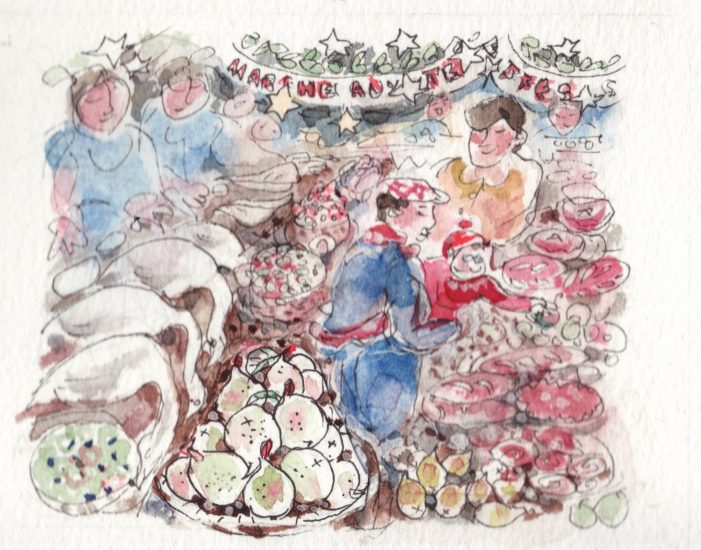
Remembrance of Christmases past
By way of an introduction to our pot-luck Kitchen Table on December 15, Elisabeth Luard remembers three of her own Christmases past:
Upsidedown Christmas in Uruguay
Fireflies in mimosa trees, fishing with a bent pin from a harbour wall, sandcastles on the beach – these are my earliest Christmas memories. I was six and my brother seven when our mother, widowed after a wartime marriage, married a junior diplomat on the Spanish circuit who was immediately posted to the British Embassy in Uruguay. Wishing to give her children and new husband a proper English Christmas, our mother ordered everything from Harrods shipped out in the diplomatic bag to Montevideo. The list included tinned Walls sausages and canned ready-cooked chestnuts, Christmas pudding in a bowl, brandy butter in a jar, glass baubles and tinsel for the tree. There were also cotton-wool snowballs and festive crackers packed in a box labelled ‘contains explosives’. These words, being translated, alerted the Uruguayan police, who confiscated the lot and rowed it all out to a small island in the River Plate, added dynamite and a long fuse, informed the population so they could watch from the beach, and triggered a huge explosion of tinsel and pudding-bits visible from Punte del Este, where government and diplomats spent their Christmas holiday among the mimosa trees and fireflies. The following year, Nanny and the children – my brother and me – were dispatched by flying boat (there was such a thing) across the River Plate to spend the holiday in Bariloche, then a summer resort for rich folk from Buenos Aires, two days across the pampas by steam-train in the Andes. Nanny, a flirtaceous redhead from Aberdeen, quickly took up with a gang of gauchos, fully booted and spurred, and cadged an invitation (horse and ponies supplied) to a cattle-round up at a nearby estancia, followed by a Christmas day spit-roast over driftwood on the shores of Lake Nahuel Huapi. The water was as blue as the sky, the mountain slopes were covered in orange-speckled tiger-lilies, and the main event (spit-roasted on a spit, basted with salt and water, eaten with the fingers) had previously accompanied us on the hoof, a lesson in reality I never forgot.
Noche Buena in Andalucia
Through the 1970’s, Christmases were spent in a remote valley in southern Spain with my young family and their very English father. Our family celebration – given that my own childhood experiences were distinctly un-English – was something of a hybrid. While our neighbours ate pata negra ham sliced from the bone (derived from a household pig of the resident semi-wild breed) with thick slabs of dense yellow-crumbed bread and olives from the brine-pot, washed down with the local wine (sherry-like), while children were supplied with crumbly almond cookies, poverones and a fudgy nougat, turron, of Moorish descent. There was also an opportunity, weather permitting, to head for the hills and cook a paella over a campfire among the cork-oaks. Meanwhile, on Christmas Eve, as the strangers in everyone’s midst, we hosted a nativity play, choice of language optional, dress-code flexible apart from the Virgin Mary, parents excluded till the performance itself, fries and icecream provided. Which was all very neighbourly, but the real challenge, at least for me, was our own non-Andaluz dinner on Christmas day. The recipe for the pudding required grated suet, pipped raisins, skinned almonds and candied orange peel, all of which had to be done by hand; brussels sprouts (obligatory) proved unobtainable; sourdough bread-sauce proved itself a mistake; and the festive goose was delivered live on end of a string by the baker’s wife (and no, she had too much else to do to help me slaughter and pluck). The spirit of Christmas, nevertheless, prevailed. Mostly.
Réveillon in Provence
On returning to London in 1978, we fell into the habit of spending Christmas in a rented house in the uplands of Provence. The region and its traditions were already familiar, result of a school year spent at the CES (primary to middle school) in Castelnaudary so the children could learn French. Festivities in the rural households of Provence start on the Eve, Reveillon (awakening) with a souper maigre, fasting supper, at which salt-cod is de rigueur either as a brandade (pureed with olive oil and a dash of cream), or as the star of a grand aioli, a thick emulsion of garlic and oil eaten with plain-cooked cardoons and winter roots. After midnight (Mass not obligatory), meat and wine is permitted and the feasting and toasting and storytelling continues till dawn. The local festive menu varied, as did ours, between home-reared foie-gras (a by-product of the winter confit d’oie) with or without truffles (bartered or foraged – only dealers from Paris pay silly prices); roast partridge or pheasant or quail stuffed with prunes or grapes; followed by dessert ordered from the best patisserie in town: tarte aux pommes, büche de noel or a brioche enriched with olive oil, pompe a l’huile. Children stay up till daybreak, or sleep where they drop, but keep out of the way of their adults on Christmas Day. Sustenance is available at all times throughout the Twelve Days as a kind of open larder – nuts, dried fruits, nougats, quince paste, melon, apples, pears, dates (tradition dictates thirteen little dishes: one for each Apostle and a sweet bread or cake for the newborn Baby) set out on a table by the door for visitors and family to help themselves. A practical tradition, and neighbourly, as befits the season of good will.
